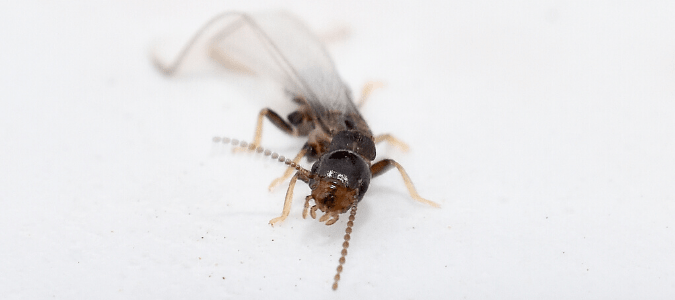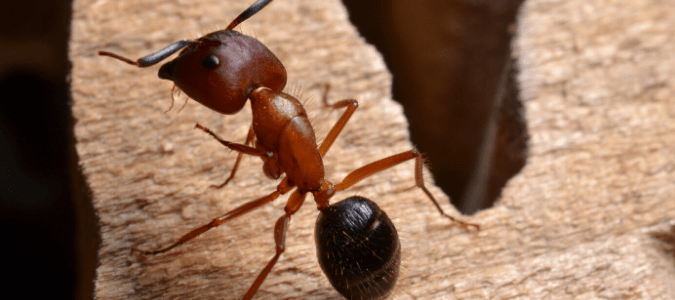
If you find damaged wood in or around your home, you might wonder whether carpenter ants or termites are to blame. Quite honestly, it can be difficult to tell if you have termites or carpenter ants without extensive pest control knowledge. While termites are responsible for $5 billion in property damage each year in the United States alone, most of this impact is linked to the subterranean varieties, which can be difficult to detect, since these species live most of their lives underground. and primarily eat away at our home’s foundation and other hard-to-access areas. Drywood termites are more likely to be spotted above ground, in similar environments as carpenter ants. One way to tell the difference between carpenter ant damage and drywood termite damage is by looking at how clean the damaged wood and surrounding area is. Generally speaking, carpenter ants tend to be pretty meticulous. Any wood that they’ve traveled through will be relatively spotless, with only tiny piles of sawdust left behind. Wood damaged by termites, in contrast, is typically riddled with mud, remains and other insect parts.
Again, though, this can be very difficult for a layperson to properly identify. For that reason, you should never start treating for either insect based on your assumption about the cause of the problem, as these pests have different behaviors and diets and, in turn, require different types of treatments. When it comes to pests that are so destructive, an effective solution requires a comprehensive strategy for inspection, identification, treatment and prevention. Moreover, the pest control products you purchase at your local hardware store just don’t provide the same level of efficiency or effectiveness as those that are available to the professionals.
That being said, as you wait for a pest control professional to arrive at your home, you can still keep an eye out for signs of a termite or carpenter ant infestation. The more information you can provide to your pest control expert, the better, so that your problem can be handled in the shortest amount of time possible to minimize damage to your biggest investment.
Signs Of A Termite Infestation
If you are concerned that you may have termites, you probably want to better understand what to pay attention to so that you can decide your best next steps. While the best way to protect your home is to schedule a regular termite inspection by a licensed professional, you can also check around your property for the following:
- Discarded wings or swarming termites. The only time you’ll probably see subterranean termites above ground is when they are looking for a location for a new colony. In the spring, these winged reproductive termites will emerge, so you may see the insects themselves or their wings near windowsills or other entry points to your home.
- Mud tubes. Subterranean termites create tunnels made of bits of saliva, soil, wood and waste materials which provide these destructive pests with the moisture and shelter they need to forage for cellulose, the primary building block of wood. Once termites locate a food source, they will consume these materials, 24 hours a day.
- Damaged wood. Since termites usually consume wood from the inside out, you probably won’t detect an issue. If you knock or tap the surface of an area impacted by termites, you can usually notice a hollow sound.
- Bubbling or uneven paint. As termites feed inside the wood of your home, the layer of paint on the surface can appear visibly different.
- Frass. Waste products from drywood termites resembles sawdust, but may be formed into a straight line or collected in a corner outside your home. Frass is typically a mix of chewed-up wood, feces, insect parts and saliva and is typically about the same color as the wood that surrounds it. Termite frass looks different depending on the species of termite that has invaded your home.
Some of the clues that you may have termites can be mistaken for water damage, including bubbled paint, blistered flooring or dark spots in wooden flooring or baseboards. This is why it is crucial to contact a pest control specialist who can determine if the damage in your home is caused by pests or something else entirely.
Signs Of A Carpenter Ant Infestation
Typically, one of the only signs of a carpenter ant infestation that a homeowner will notice is small holes drilled into wood with tiny piles of sawdust right outside of them. This sawdust is composed of wood fragments, soil and insect parts. Carpenter ants prefer moist or rotting wood, so you’re more likely to spot these holes near wood that has water damage or is in close proximity to water. Some homeowners may hear rustling sounds in their walls from carpenter ants, but these pests are nocturnal and relatively quiet so this isn’t too common.
As you can tell, carpenter ants and termites are stealthy invaders. More often than not, your first sign of an infestation will be when the reproductives, also called swarmers, fly out of the nest.

Winged Ant Vs. Termite Swarmers
When termite and ant colonies get big enough, the reproductives will develop wings and become swarmers. These swarmers have a specific job in the colony. When the timing is right, they fly out of the nest to pair up, reproduce and set up other colonies. Swarmers tend to appear and look for new nests as the weather starts to warm up. Termite swarms typically occur in the early spring on a warm day after some rainfall. Carpenter ants, on the other hand, typically swarm sometime between May to June.
One difference between carpenter ants and termites is the time of day swarmers are active. Swarming termites are more likely to search for a new area to nest during the daytime. Once the sun goes down, carpenter ants swarmers are more likely to emerge. Not only are swarmers out to look for new colonies at night, but other castes of carpenter ants are also looking for food and expanding their tunnels at night as well. Of course, you may still spot a carpenter ant during the day which is why it’s important to take a close look at the body and wings of the pest to identify what type of infestation you might be dealing with.
Swarmers look similar from a distance. A few differences can help you determine whether what you are seeing is termites or carpenter ants.
What Swarming Termites Look Like
As pictured above, a swarming termite is:
- Typically about a quarter of an inch long
- Cream, dark brown or black in color
- Made up of three segments (the head, thorax and abdomen)
- Broad in the waist area
- Six-legged
Termite wings can vary in color, ranging from gray to dark brown. Termites have wings that are equal in size. At the top of a termite’s head are straight antennae. These two characteristics are the easiest way to tell flying termites apart from carpenter ants.
What Swarming Carpenter Ants Look Like
A swarming carpenter ant is:
- Typically between a quarter of an inch to a half of an inch long
- Black
- Two-segmented (head and thorax)
- Pinched in the waist
- Six-legged
At first glance, a carpenter ant and termite might look the same. But, carpenter ants have two sets of wings that are much different in size. Additionally, their antennae are bent, rather than straight.
Once swarmers have done their job, their wings will fall off. If termites swarm while you’re away, you might come home to piles of discarded wings along window sills or near entryways. Signs of swarmers in the home indicate that a mature colony has likely already been established. If you notice a pile of these wings outside your home, swarmers were likely trying to get in. Even if they are not established in your home, there is probably a good-sized population somewhere near your home.
If this describes your situation, you may decide, like many homeowners do, to contact a professional. If termites or carpenter ants have invaded, it’s more than just unpleasant. Due to the diets and habits of these pests, an infestation is also dangerous and expensive. Letting a carpenter ant or termite infestation continue to grow may lead to serious property damage that costs tens of thousands of dollars in repairs. Moreover, carpenter ants and termites both threaten the wooden foundation of your home—meaning it is more likely that accidents may happen due to structural damage. You can minimize damage or put protective measures in place with the help of an experienced pest control specialist.
With the presence of these pests on your property, you’re likely wondering whether these pests eat wood or something else entirely, and how their diet affects the amount of damage these pests can cause to your home.

Do Carpenter Ants Eat Wood?
Although carpenter ants tunnel through wood in order to hollow out a space for their nest, they don’t actually eat wood as termites do. Carpenter ants prefer sugary snacks or pet food filled with protein. If these insects are living outside of a home, they might feast on an animal carcass or other insects.
While carpenter ants don’t eat the wood in your house, that doesn’t mean these pests aren’t destructive. Carpenter ants will still dig through and damage wood throughout your home. As we touched on above, this wood is used to create nests, tunnels and other forms of shelter for carpenter ants. The more damp and decayed the wood is, the more likely it is that a carpenter ant will want to live in it. If this type of wood is not available, foam insulation can also provide shelter for carpenter ants.
Termites are one of the few creatures that can eat and digest wood. However, what is less well known is that these destructive insects will eat anything that contains cellulose. Cellulose is a substance that is found in many items around our home, from plastic to plants. In fact, cellulose is the most common organic compound found on the planet. Due to the makeup of building materials, termites are much more likely to snack on wood when they’re in your house. But in a pinch, they’ll happily feast on drywall, paper, boxes and more.
Whether you have found signs of termites or carpenter ants on your property, you are probably concerned. With the damage that these pests are capable of, your best route is to contact a reliable pest control professional.
ABC Can Handle Any Type of Pest Problem
Finding frass or noticing a carpenter ant or termite swarm can be overwhelming. If you’re experiencing signs of a wood-destroying insect infestation in your home, or even if you suspect you have a problem, contact ABC Home & Commercial Services. Our experienced pros can provide you with a thorough inspection and customized treatment plan to eliminate the entire colony and protect your biggest investment from future damage.
